 |
“Remember the two benefits of failure. First, if you do fail, you learn what doesn't work; and second, the failure gives you the opportunity to try a new approach.”
― Roger Von Oech
Being aquarists, we flirt with failure every day; and the larger the system, the higher the risk. If you have been in this hobby long enough, you have surely seen your share of problems; some not so bad, some perhaps catastrophic. Given the investment in money, time, and personal energy, it’s no wonder that reef keepers are so passionate about this hobby. We have a lot to lose. When failures occur, that is when it is important to take stock, learn, and improve. The dictionary defines resiliency as an occurrence of rebounding or springing back. Our story is about resiliency of our systems, as well as of ourselves.
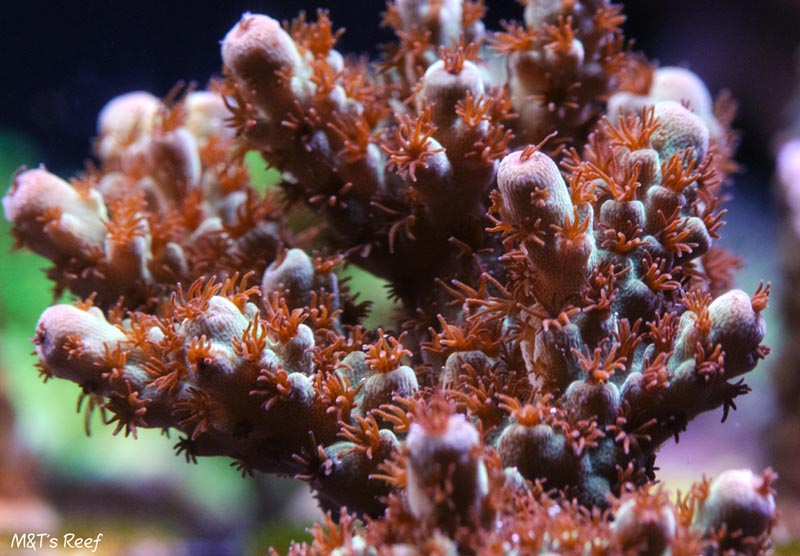 |
Terry and I have been amateur aquarists for many years; when we first met back in the 1980s we had a primitive marine aquarium. In those days, the knowledge and techniques were limited; there wasn’t an internet to research all the topics that are essential to keeping a successful system. We had to rely upon the few books that were out at the time, or the occasional interaction with a fellow “early adopter” at a local fish store. We didn’t know about filtration or lighting advances that were being made in Europe or some of the larger areas in the US - it was pretty much all about a few fish, inverts, and doing water changes trying to keep them alive. When we encountered problems, it was very difficult to solve them, since we were pretty much on our own. Still, we were learning.
As the years went by, we grew into larger systems, and eagerly adopted the emerging technologies of protein skimming, improved lighting, test kits, dosing techniques and equipment. By the late 90’s, the internet became widely available and things really started to take off in the hobby. With the widespread sharing of knowledge and techniques, our ability to keep a more diverse collection of livestock grew. We had our share of problems, but by then we had a huge pool of resources to tap into in order to solve them. More advances led to more equipment, more complexity, more automation, and of course, more things that could go wrong.
By 2003, we had upgraded to a large tank (125g), and we had successfully built a nice mixed reef. We had auto top-off, a calcium reactor, refugium, closed loop, and more. But what was missing was an integrated design; we had too much equipment depending on a single electrical outlet and power strip. One weekend when we were out of town, a small leak caused a power outage that almost wiped out the entire system. Luckily, a friend was watching the tank for us and called a local fish store whom immediately sent over someone to get things cleaned up and running again. We dodged a bullet, but that experience drove us to run 2 dedicated circuits to our system and organize the wiring so that the risk of water mixing with electricity was greatly reduced. We found Playfair’s DIY battery back-up design on Reef Central and built that to provide some power redundancy.
By 2006, we had upgraded again to a 180g SPS-dominated display tank with remote fish room. Our tank was looking gorgeous; we had huge colonies of SPS and were doing a lot of coral trading with local club members. We got lazy with our QT procedures and ended up with a bad case of acropora-eating flatworms (AEFW) that nearly wiped out our entire system. We lost most of our large SPS colonies and endured the agonizing chore of weeks of dips, removing flatworms, and scraping eggs. No kidding, we were very tempted to give up the hobby several times during that ordeal. But we persevered and instead of quitting, we implemented very rigorous QT for everything we bought or traded. This includes corals, fish, you name it. If the new animal cannot live through the QT, then it will not make it to our display. It is a costly and time-consuming commitment, but we are convinced that it is the smart thing to do.
In early 2010, we upgraded yet again from our 180g to a 300g display. This was to be our dream tank installation. We put all of our combined years of aquarium experience into the design and setup of our new tank. Everything went well with the installation and we were so proud of our beautiful new system. It had dual independent drain lines to the sump, massive schedule-80 PVC bulkheads for the closed loop fittings, spa-flex flexible PVC plumbing…it was fantastic. But just six short months after the grueling installation was complete, came the dreadful night in September that Terry heard water splashing on the floor. She called out to me and I said “That’s not possible! The tank cannot overflow!” But when I looked, it wasn’t overflowing, the bottom seal had failed and water was gushing out from the back right corner. Almost half of the tank water drained onto our floors that night. It ruined several hundred square feet of hardwood floors, resulting in thousands of dollars of damage. Water ran into a wall outlet and caused a fire. Luckily, we were home that night and were able to quickly contain the fire, move water and livestock to temporary vats and save most all the animals.
We were devastated since we had put all of our effort and resources in to that build only to have it crash so soon after getting it up and running. That was a very trying period for us; we contemplated getting out of the hobby altogether and cutting our losses. Our local club, family, and online friends from all over the world provided support and encouraged us to stay with it. It took months to repair the house and get a replacement tank, but we were resilient. We bounced back. The new tank had eurobracing along the bottom to strengthen the bottom seal. We built a much stronger stand. The floor was structurally reinforced. We moved all electrical to a different room away from the display tank.
Now here we are, the replacement 300g is almost 3 years old, running well, and we’ve been nominated for Reefkeeping Magazine Tank of the Month. Over the years, we’ve put our hearts, backs, and paychecks into these beautiful reef tanks. We’ve had a lot of ups and downs, but it’s not the destination, it’s the journey that makes it all worthwhile.
 |
• Display aquarium: 300g Marineland Deep Dimension glass tank (72”x 36“x 27”) with custom center-mounted overflow and bottom eurobracing
• Display Stand: DIY wooden stand with furniture-grade cabinetry and canopy, Quartz countertops, tank surround, and backsplash
• Sump: 150g sump with live rock and 70g shallow sump
• Return Pump Iwaki MD70RLT
• Frag Tank: 50g AquaBox custom mixed-media frag tank
• Skimmer: Super Reef Octopus 6000-SSS internal skimmer, Deltec AP851 skimmer
• Sterilizer: 57W Aqua UV Ultraviolet Sterilizer
• Circulation: 5-way closed loop powered by Reeflo Dart and Ocean Motion 4-way, (4) Tunze 6095 Turbelle NanoStreams, (1) Tunze 6105 Turbelle Stream
• Water Controller Tunze 7095 multicontroller
• Lighting: (3) 400w mogul metal halides – Ushio 14,000K bulbs, (2) 72” VHO fluorescents – URI super actinic bulbs (morning/evening), (6) Ecoxotic LED stunner strips (for dawn/dusk)
• System Control & Automation: Neptune Systems Apex controller with (2) EB8’s and DIY breakout box
• Top Off / Water Change: Air Water & Ice Typhoon III 75 g/day RO/DI, Reef Fanatic level controllers integrated with Apex, DIY mixing station with 100g freshwater & 100g saltwater mixing vats, Bi-weekly water changes with AquaCraft Marine Environment salts
• Media Reactors: Two Little Fishies 550 media reactors (GFO and GAC, as needed)
• Calcium: Geo 818 Calcium Reactor, with Precision Marine secondary effluent chamber, Geo Kalkwasser Reactor (via Apex)
• Additives: Magnesium weekly, Strontium daily, Iodine weekly, or as-needed
• Ozone: Milwaukee ORP controller
“Simplicity is the ultimate sophistication.”
― Leonardo da Vinci
Before we add something new to the system, or implement improvements, we try to spend some quality time with paper and pencil first to think through how things should best fit together or integrate into our overall setup. This is always time well-spent! It really can pay off to think things through before whipping out the credit card or the tools. This applies to everything in the system; from wiring and plumbing, to equipment, and even livestock additions. We find it is always best to start off with a good plan. Lessons learned from failures are not the only considerations that we employ into our designs, although they certainly tend to be some of the most important. There are also some guiding principles we try to follow: simplicity, resiliency (there’s that word again!), and doing it right the first time.
Complexity creates risk of failure. The more complicated things get, the more likely that something will go wrong, or the more difficult it becomes to anticipate (and head off) potential problems. It is almost always more work to create an elegant, simple solution than something jury-rigged, so we have to fight the tendency to allow such things to build up over time. We’ve all seen pictures of those under-stand sump conditions with wires and hoses going every-which-way. Almost always, those conditions are disasters waiting to happen. We aren’t perfect here, there are certainly times where we slap in a quick fix; but the point here is to routinely review the system, go back and straighten things up, reduce complexity where possible, and try to “keep it simple, shhweetheart.” An example of this in our system is the use of a manifold in the sump to serve up supply water to our various reactors. We could have chosen to use a variety of dedicated pumps or power heads to supply water to the calcium reactor, the GAC reactor, the GFO reactor, etc., but this creates complexity and more maintenance. The elegant solution was to build a manifold plumbed into the main return pump. This is one of many DIY ideas we got from friends on RC such as Joseph Weatherson and Brett (drummer reef).
Related to the KISS principle is resiliency. Terry and I routinely review our systems with this question in mind: “What is the worst that can go wrong if this _____ fails?” The idea is to create a continuous improvement cycle for all the components and processes in the system. And the more we practice this, the better we become at spotting those diabolical little failures-in-waiting. Almost everyone with a sump hears the advice to “simulate a power failure and ensure there’s enough room in your sump for the drain-back”. This is a good elementary example of a resiliency review. Everyone with a reef tank should take this to the next level and look at how their systems will faire during a power outage. Examine all aspects of your system – lighting, water flow, filtration, oxygenation, etc. A resilient design that allows the system to endure power outages is critical for long-term success and protecting the significant investment that comes with large reef systems. We employ a layered design for electrical protection; the first being the most affordable and easy to implement: portable battery-backup air pumps. We highly recommend the “auto on” styles that are plugged into the electrical outlet but only activate when the utility power fails. If you take away anything from this article, please install these in your system! It can literally be the difference between an inconvenient outage and a disastrous system crash. Our second layer of power resiliency is a battery backup system that provides power to our main return pump and primary skimmer in the event of a utility outage. Lastly, we maintain a gasoline-powered generator and prewired transfer circuit to provide power to critical components of our reef system during extended utility outages.
DIRTFT (Do it right the first time) – now here is a design principle that is hard to argue with, but not exactly easy to do every time. This topic is tied to the overall idea of investing in good planning before jumping in to solve that next problem. For us, this boils down to taking the time to thoroughly research our next project or purchase and saving up our money for quality materials, equipment, or livestock. The online forums are full of stories about hobbyists who rush out and buy the first (often cheapest) thing, only to have it fail quickly due to poor quality, poor integration into the existing system (think equipment and livestock here), or just a bad impulse buy (especially livestock). The result is wasted time, money, or worse – unnecessarily injured or killed animals. It is so much better to take the time to study up on things before we embark on that next project or purchase - especially when it comes to the animals.
Terry and I both enjoy researching livestock and building our knowledgebase of behavior and needs of fish, coral and other inverts - both before and after our purchases. Terry is very passionate about our fish – she refers to them as her “babies” and she certainly has a bond with them. Thanks to folks like Brad Syphus, Kevin Kohen, and Tony Vargas, she has developed an affinity for wrasses - aka “wrasse fever” and is very interested in learning as much as she can about these wonderful animals. I enjoy the fish as well, but have always been into SPS corals and all the technical aspects of improving the system so that we can successfully keep the more challenging SPS species. Together, we make a great team.
“All human errors are impatience, a premature breaking off of methodical procedure...”
― Franz Kafka
When Terry and I first started keeping marine tanks, our livestock choices were pretty narrow. In the 1980’s, there were relatively few fish and inverts being imported, and almost no corals. As technology and husbandry have improved, so have the selection of animals we can choose from to stock our aquariums. Along with this wider set of choices, comes the responsibility to choose those animals that are right for our skill levels and systems. It is so easy to fall into the trap of the “impulse buy” – to add livestock that we find very attractive without regard to the long-term needs of the animal. Conscientious aquarists demonstrate the patience to research these needs, and evaluate their ability to provide for them before the purchase. For our big display, we are quite selective about the animals we add, to complement the overall design and aesthetics, and integrate well with the community of corals and fish. Thanks to our friend Kinlayan for inspiring us to go the extra mile in this regard, he is a beacon for passionate care of animals.
We keep several species of “questionable selections” in our display. We find that many fish and inverts labeled “non-reef-safe” can be effectively kept by simply paying attention to their needs and behaviors and managing accordingly. Many hobbyists feel that coral-nippers are unwelcome in the SPS display. On the contrary, we find that healthy, thriving SPS can easily tolerate the occasional Angelfish plucking, and that actually promotes vigorous SPS growth. Another important aspect of long-term SPS health is the cultivation of commensal crabs. We find that even some of the “big and hairy” crabs often shunned by some can be friends of large coral colonies, by keeping detritus and pests out, and stimulating the coral with their frequent grooming and other activities.
Quarantine is another one of those things that is a no-brainer conceptually, but challenging to do. We have evolved our QT techniques over the years, and as with other good husbandry practices we find that it gets easier with time. First, we start with a mindset that the health of our system and animals is most important. Second, the risk of not doing it is great motivation – the internet is full of stories of agonizing losses of livestock and even entire systems that could have been avoided with a simple QT approach. We keep a quarantine tank set up constantly, and it is normally occupied by: a new addition, a sick animal that is being treated, a misbehaving fish needing time-out, or even livestock that we simply want to carefully observe to better understand its needs and behaviors.
We often get asked questions about how we introduce new fish (especially wrasses) into our existing systems. We make use of a “promotion system”, to minimize introduction stress and provide the best chances of successful acclimation and survival. All of our new arrivals undergo QT (typically a minimum of 6 weeks) for all the usual reasons. At that point, depending on their size, activity levels, and feeding habits, we will decide if they are ready for one of several “stage two” tanks. For some, we may place them into Terry’s calm rimless tank while they learn to interact with other fish, increase their size, or allow us to observe how they interact with invertebrates. Others may be candidates for the prop tank, for some of the same reasons (but different types of corals and fish), or we may deem them ready to go into the big SPS display. Without exception, fish being promoted to the big display will spend a few days in an acclimation box. We have several sizes of acclimation box that we use, mainly to accommodate multiple new additions at the same time. Sometimes we find it useful to introduce new fish either in pairs or groups so that the attention of the established population isn’t drawn to just one new tank mate. We may even purchase “buddy fish” for this purpose – or “demote” an existing fish from the display to re-introduce at the same time as a new member. This technique is highly effective – by removing established fish to a “time out” location for a period of time, it can greatly reduce aggression between similar species.
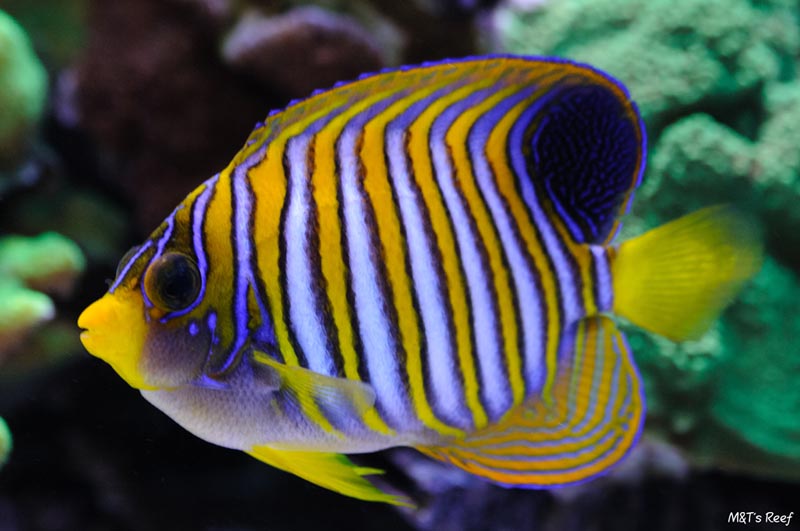 |
• Acropora: abrotenoids, akajimensis, austera, brueggemanni, carduus, clathrata,, efflorescens, gomezi,granulosa,hyacinthus, kimbeensis, macrostoma, millipora, microclados, nasuta, plana, prostrata, retusa, rosaria, samoensis, sarmentosa,secale, selago, solitaryensis, speciosa, spathulata, subulata, tenuis, tortuosa, verweyi, yongei
• Stylophora pistillata
• Montipora: setosa, undata, and various encrusting species.
• Pocillopora sp.
• Seriatopora: hystrix, guttatus
• Blastomussa merletti
• Favia sp.
• Echinophylia sp.
• Palythoa sp.
• Sea cucumber (Holothuria sp.)
• Scarlet Skunk Cleaner Shrimp (Lysmata amboinensis)
• Yellow Coral Banded Shrimp (Stenopus scutellatus)
• Fighting conch (Strombus alatus) Brittle stars (Ophiure protoreaster)
• Assorted Nassarius, Cerith, Nerite, and Astrea snails
• Red, blue-legged hermits
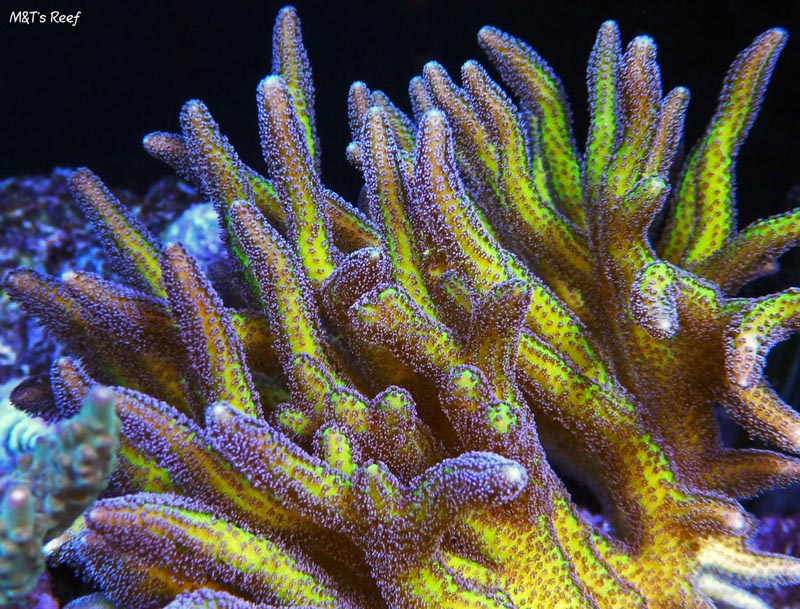 |
“We are what we repeatedly do. Excellence, then, is not an act, but a habit.”
― Aristotle
Aristotle was a pretty smart dude, we’re told. The importance of consistency and stability in keeping a healthy thriving reef aquarium is irrefutable. The methods and equipment employed are as diverse as the people using them, but having the discipline to keep a steady set of good husbandry practices going is the secret sauce known to every successful reef keeper. We don’t employ a lot of fancy techniques; rather we try to just keep it consistently simple. Here are a few of the things that we have found work best for us:
• Weekly water changes of at least 10% total volume
• Testing of key water parameters 2-4 times per month
• Use of filter socks to remove particulates from the water column
• Heavy protein skimming, with weekly cup and neck cleaning
• Quarterly cleaning of pumps and overflows
• Weekly cleaning of U/V sterilizer sleeve
• Monthly cleaning of all light fixtures and bulbs, with frequent replacement of bulbs that start to show signs of color shifts or output
• Daily monitoring of livestock – appearance, behavior, growth, etc. This important step sounds so simple and fundamental, but we are surprised by how many people fail to take the time to carefully observe their animals. The fish, corals, and inverts will be the first to tell us that there is trouble brewing, but we must be watching!
• Methodical record-keeping – we maintain a log of water tests, maintenance, upgrades, new livestock additions and any noteworthy observations. This takes practice to get in the habit, but the insights gained from a simple ledger or log book will surprise you!
|
Water Parameter Targets:
|
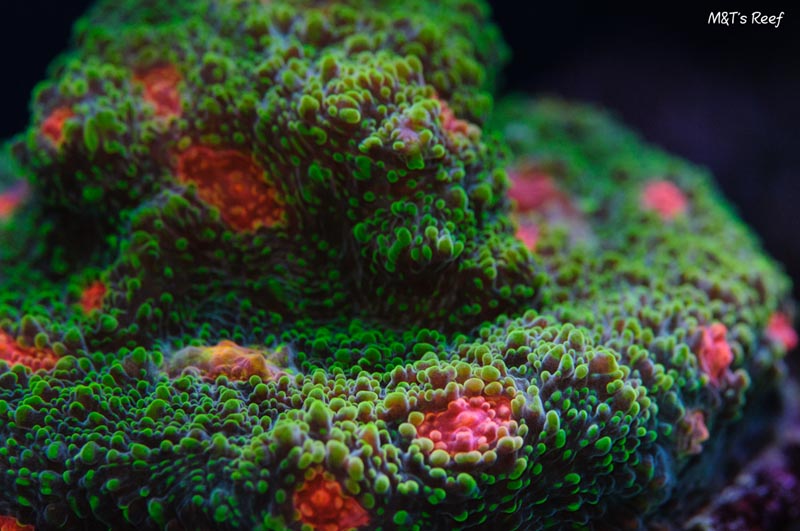 |
• Regal Angel – Pygoplites diacanthus
• Bellus Angels – Genicanthus bellus (mated pair)
• Flame Angel – Centropyge loricula
• Desjardini Tang – Zebrasoma desjardini
• Squaretail bristletooth – Ctenochaetustruncatus
• Lyretail Anthias – Pseudanthias squamipinnis
• Blotched Anthias – Holanthiasborbonius
• False Percula Clownfish – Amphiprion ocellaris (mated pair)
• Tomentosus Filefish – Acreichthystomentosus
• Earle’s Fairy Wrasse – Cirhilabrus earlei (mated pair)
• Lineatus Wrasse – Cirrhilabrus lineatus
• Johnson’s Fairy Wrasse – Cirrhilabrus johnsoni
• Rhomboid Fairy Wrasse – Cirrhilabrus rhomboidalis
• Red Velvet Fairy Wrasse – Cirrhilabrus rubrisquamis
• Royal Flasher Wrasse – Cirrhilabrus angulatus
• Diamond Tail Flasher Wrasse – Paracheilinus attenuatus
• Eightline Flasher Wrasse – Paracheilinus octotaenia
• Blue Star Leopard Wrasse – Macropharyngodon bipartitus
• Kuiter’s Leopard Wrasse – Macropharyngodon kuiteri
• White Stripe Terelabrus – Terelabrus sp. (pair)
• African Cleaner Wrasse – Labroides dimidiatus
• Banggai Cardinalfish – Pterapogon kauderni (tank bred)
• Neon Goby – Elacatinus oceanops
• Blue Green Chromis – Chromis viridis
• One Spot Foxface Rabbitfish – Siganus unimaculatus
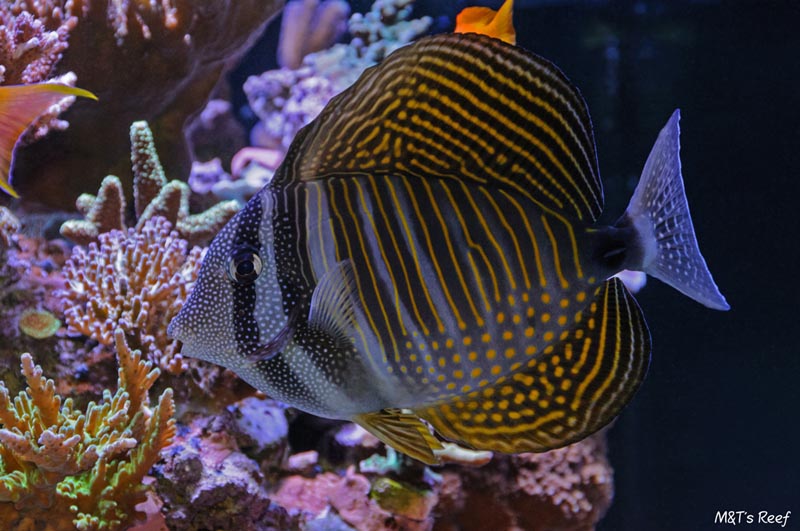 |
“If I have seen further, it is by standing on the shoulders of giants.”
― Isaac Newton
So many people have contributed to our wonderful hobby over the years; from noted scientists and authors to local hobbyists, we try to glean what we can from every source. The trick is knowing how to separate fact from fiction, and applying equal parts of healthy skepticism, being open to new ideas, and leveraging the experience of others.
Terry and I want to express our sincere gratitude to the following people for their inspiration, guidance, and help over the years: Richmond Reef Club, Rick S, LB, Crabby10, Larry Combs, blumoon reefers, Kevin Kohen, Luc Loyen, Kinlayan, Joseph Weatherson, Brad Syphus, Tony Vargas, Sanjay Joshi, Paul Whitby, Joe Burger, Leonardo den Breejen, Brett (drummer reef), Randy Holmes-Farley, riemannp, TeeSquare, and crvz.
We also want to thank everyone who has participated in our Reef Central build thread – we avoided many missteps by listening to their advice. Lastly, we owe a great debt of gratitude to our friends and family who have supported us and our crazy fascination with reef keeping. Thanks everyone!
 |
Feel free to comment or ask questions about my tank in the Tank of the Month thread on Reef Central.